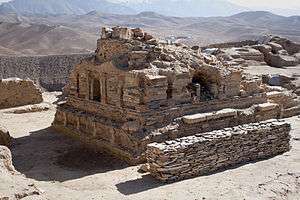Zunbils
Zunbil, also written as Zhunbil, was a Hindu dynasty south of the Hindu Kush in present southern Afghanistan region. They ruled from the early 7th century until the Islamic conquest of Afghanistan in 870 AD. The Zunbils are believed to be an offspring of the southern-Hephthalite rulers of Zabulistan.[1] The dynasty was related to the Kabul Shahis of the northeast in Kabul. "It follows from Huei-ch'ao's report that Barhatakin had two sons: one who ruled from after him in Kapisa-Gandhara and another who became king of Zabul".[2]
The Zunbils worshipped the sun, which they named Zun (read as /zuːn/; ZOON) from which they derived their name.[3] Their territory included between what is now the city of Zaranj in southwestern Afghanistan and Kabulistan in the northeast, with Zamindawar and Ghazni serving as their capitals.[4] The title Zunbil can be traced back to the Middle-Persian original Zūn-dātbar, 'Zun the Justice-giver'. The geographical name Zamindawar would also reflect this, from Middle Persian 'Zamin-i dātbar' (Land of the Justice-giver).[5]
History

According to Anthony McNicoll, "the Zunbils ruled in the Kandahar area for nearly 250 years until the late 9th century AD".[6] Their main capital Zamindawar was located in the present-day Helmand Province of Afghanistan. The shrine of Zoon (sun god) was located about three miles south of Musa Qala in Helmand, which may still be traced today. Some believe that the Sunagir temple mentioned by the famous Chinese traveler Xuanzang in 640 AD pertains to this exact house of worship.[3]
In 653-4 AD, an army of around 6,000 Arabs were led by General Abdur Rahman bin Samara and they arrived to the shrine of Zoon in Zamindawar. It is reported that General Abdur Rahman "broke off a hand of the idol and plucked out the rubies which were its eyes in order to persuade the Marzbān of Sīstān of the god's worthlessness."[7] The General explained to the Marzbān: "my intention was to show you that this idol can do neither any harm nor good."[8] At this point some of the people of southern Afghanistan accepted Islam for the first time . In 698 Ubayd Allah b. Abi Bakra lead the 'Army of Destruction' against the Zunbils and was defeated. About 700 Ibn al-Ash'ath tried again with the 'Peacock Army' which led to a mutiny.[9]
Saffarid and Zunbil Struggles
C.E. Bosworth writes that:
One of the most important aspects of early Saffarids policy of significance for the spread of Islam in Afghanistan and on the borders of India long after their empire had collapsed was that of expansion into east Afghanistan. The early Arab governors of Sistan had at times penetrated as far as Ghazna and Kabul, but these had been little more than slave and plunder raids. There was a fierce resistance from the local rulers of these regions, above all from the line of Zunbils who ruled in Zamindavar and Zabulistan and who were probably epigoni of the southern Hepthalite or Chionite kingdom of Zabul; on more than one occasion, these Zunbils inflicted sharp defeats on the Muslims. The Zunbils were linked with the Kabul-Shahs of the Turk Shahi dynasty; the whole river valley was at this time culturally and religiously an outpost of the Indian world, as of course it had been in the earlier centuries during the heyday of the Buddhist Gandhara civilization.[10]
Religion
The Zunbils worshiped the sun god Zun, a form of Hindu god Surya sometimes referred to as Zoor or Zoon. He is represented with flames radiating from his head on coins. Statues were adorned with gold and used rubies for eyes.[3] The god appears to have been brought to the region by the Hephthalites.[1] Over time, the region was incorporated into Hinduism, with aspects of Shiva[1] and Surya[3] incorporated.[1] The cosmopolitan nature of the god is consistent with the variety of religions practiced in the region prior to the Islamization of Afghanistan.
Games
In the computer game Crusader Kings II, by Paradox interactive, the Zunbils is a playable dynasty. They practice the Zunist religion, which is -in the game- not related to any other religion.
See also
References
- 1 2 3 4 Andre Wink, Al-Hind, the Making of the Indo-Islamic World, Vol.1, (Brill, 1996), 115;""The Zunbils of the early Islamic period and the Kabulshahs were almost certainly epigoni of the southern-Hephthalite rulers of Zabul."
- ↑ History of Civilizations of central Asia, B A Litivinsky Zhang Guang-Da, R Shabani Samghabadi, p.376
- 1 2 3 4 "The Temple of Zoor or Zoon in Zamindawar". Abdul Hai Habibi. alamahabibi.com. 1969. Retrieved August 14, 2012.
- ↑ André Wink, "Al-Hind: The Making of the Indo-Islamic World", Brill 1990, p. 118
- ↑ Bosworth, Clifford Edmund. 2002. The Encyclopaedia of Islam. Leiden: Brill. Zamindawar. p.439.
- ↑ Excavations at Kandahar 1974 & 1975 (Society for South Asian Studies Monograph) by Anthony McNicoll
- ↑ André Wink, "Al-Hind: The Making of the Indo-Islamic World", Brill 1990. p 120
- ↑ "Amir Kror and His Ancestry". Abdul Hai Habibi. alamahabibi.com. Retrieved August 14, 2012.
- ↑ Hugh Kennedy,The Great Arab Conquests',2007, pages 194-198
- ↑ The Tahirids and Saffarids, C.E.Bosworth,The Cambridge History of Iran:From the Arab Invasion to the Saljuqs, Vol. IV, Ed. Richard Nelson Frye, William Bayne Fisher and John Andrew Boyle, (Cambridge University Press, 1975), 111. ISBN 0-521-20093-8, ISBN 978-0-521-20093-6
